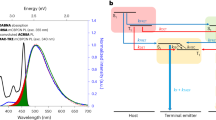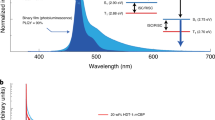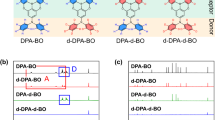Abstract
Highly efficient and stable blue organic light-emitting diodes (OLEDs), although required for display and lighting applications, remain rare. Here we report a molecular perdeuteration strategy to stabilize blue thermally activated delayed fluorescence (TADF) emitters. Perdeuterated sky-blue TADF emitters exhibit higher efficiencies and doubled device lifetime in OLEDs compared with protonated emitters, owing to suppressed high-energy vibrations. Perdeuteration also leads to blue-shifted and narrowed spectra in the solid state, which in turn improves the Förster energy transfer to the deep-blue final emitter in TADF-sensitized fluorescent OLEDs. These devices exhibit a maximum external quantum efficiency of 33.1% and a lifetime to reach 80% of the initial luminance of 1,365 h with a Commission Internationale de l’Eclairage y coordinate of 0.20 at a luminance of 1,000 cd m−2, even outperforming blue phosphorescent OLEDs. Our perdeuteration strategy improves the device performance of blue OLEDs, paving the way for their broader applications in displays and lightings.
This is a preview of subscription content, access via your institution
Access options
Access Nature and 54 other Nature Portfolio journals
Get Nature+, our best-value online-access subscription
$29.99 / 30 days
cancel any time
Subscribe to this journal
Receive 12 print issues and online access
$209.00 per year
only $17.42 per issue
Buy this article
- Purchase on Springer Link
- Instant access to full article PDF
Prices may be subject to local taxes which are calculated during checkout




Similar content being viewed by others

Data availability
The data supporting the findings of this study are available within the paper and its supplementary information file. Source data are provided with this paper.
References
Wang, D., Cheng, C., Tsuboi, T. & Zhang, Q. Degradation mechanisms in blue organic light-emitting diodes. CCS Chem. 2, 1278–1296 (2020).
Tang, C. W. & VanSlyke, S. A. Organic electroluminescent diodes. Appl. Phys. Lett. 51, 913–915 (1987).
Tang, C. W., VanSlyke, S. A. & Chen, C. H. Electroluminescence of doped organic thin films. J. Appl. Phys. 65, 3610–3616 (1989).
Baldo, M. A. et al. Highly efficient phosphorescent emission from organic electroluminescent devices. Nature 395, 151–154 (1998).
Ma, Y., Zhang, H., Shen, J. & Che, C. Electroluminescence from triplet metal-ligand charge-transfer excited state of transition metal complexes. Synth. Met. 94, 245–248 (1998).
Uoyama, H., Goushi, K., Shizu, K., Nomura, H. & Adachi, C. Highly efficient organic light-emitting diodes from delayed fluorescence. Nature 492, 234–238 (2012).
Kaji, H. et al. Purely organic electroluminescent material realizing 100% conversion from electricity to light. Nat. Commun. 6, 8476 (2015).
Wada, Y., Nakagawa, H., Matsumoto, S., Wakisaka, Y. & Kaji, H. Organic light emitters exhibiting very fast reverse intersystem crossing. Nat. Photonics 14, 643–649 (2020).
Masui, K., Nakanotani, H. & Adachi, C. Analysis of exciton annihilation in high-efficiency sky-blue organic light-emitting diodes with thermally activated delayed fluorescence. Org. Electron. 14, 2721–2726 (2013).
Sun, J. et al. Exceptionally stable blue phosphorescent organic light-emitting diodes. Nat. Photonics 16, 212–218 (2022).
Zhang, D., Cai, M., Zhang, Y., Zhang, D. & Duan, L. Sterically shielded blue thermally activated delayed fluorescence emitters with improved efficiency and stability. Mater. Horiz. 3, 145–151 (2016).
Noda, H., Nakanotani, H. & Adachi, C. Excited state engineering for efficient reverse intersystem crossing. Sci. Adv. 4, eaao6910 (2018).
Lee, J. et al. Hot excited state management for long-lived blue phosphorescent organic light-emitting diodes. Nat. Commun. 8, 15566 (2017).
Zhang, D. et al. High-efficiency fluorescent organic light-emitting devices using sensitizing hosts with a small singlet–triplet exchange energy. Adv. Mater. 26, 5050–5055 (2014).
Nakanotani, H. et al. High-efficiency organic light-emitting diodes with fluorescent emitters. Nat. Commun. 5, 4016 (2014).
Furukawa, T., Nakanotani, H., Inoue, M. & Adachi, C. Dual enhancement of electroluminescence efficiency and operational stability by rapid upconversion of triplet excitons in OLEDs. Sci Rep. 5, 8429 (2015).
Zhang, D. et al. Efficient and stable deep‐blue fluorescent organic light‐emitting diodes employing a sensitizer with fast triplet upconversion. Adv. Mater. 32, 1908355 (2020).
Huang, T. et al. Simultaneously enhanced reverse intersystem crossing and radiative decay in thermally activated delayed fluorophors with multiple through-space charge transfers. Angew. Chem. Int. Ed. 60, 23771–23776 (2021).
Huang, T., Wang, Q., Meng, G., Duan, L. & Zhang, D. Accelerating radiative decay in blue through‐space charge transfer emitters by minimizing the face-to-face donor–acceptor distances. Angew. Chem. Int. Ed. 61, 202200059 (2022).
Kondo, Y. et al. Narrowband deep-blue organic light-emitting diode featuring an organoboron-based emitter. Nat. Photonics 13, 678–682 (2019).
Chan, C.-Y. et al. Stable pure-blue hyperfluorescence organic light-emitting diodes with high-efficiency and narrow emission. Nat. Photonics 15, 203–207 (2021).
Jeon, S. O. et al. High-efficiency, long-lifetime deep-blue organic light-emitting diodes. Nat. Photonics 15, 208–215 (2021).
Zhang, D. & Duan, L. TADF sensitization targets deep-blue. Nat. Photonics 15, 173–174 (2021).
Tong, C. C. & Hwang, K. C. Enhancement of OLED efficiencies and high-voltage stabilities of light-emitting materials by deuteration. J. Phys. Chem. C 111, 3490–3494 (2007).
Abe, T., Miyazawa, A., Konno, H. & Kawanishi, Y. Deuteration isotope effect on nonradiative transition of fac-tris(2-phenylpyridinato) iridium (III) complexes. Chem. Phys. Lett. 491, 199–202 (2010).
Wang, P. et al. Synthesis of all-deuterated tris(2-phenylpyridine)iridium for highly stable electrophosphorescence: the ‘deuterium effect’. J. Mater. Chem. C 1, 4821–4825 (2013).
Cheng, J.-F. et al. Positive isotope effect in thermally activated delayed fluorescence emitters based on deuterium-substituted donor units. Chem. Eng. J. 430, 132822 (2022).
Bae, H. J. et al. Protecting benzylic C–H bonds by deuteration doubles the operational lifetime of deep-blue Ir-phenylimidazole dopants in phosphorescent OLEDs. Adv. Opt. Mater. 9, 2100630 (2021).
Liu, X. et al. Isotope effect of host material on device stability of thermally activated delayed fluorescence organic light‐emitting diodes. Small Sci. 1, 2000057 (2021).
Yao, J., Dong, S.-C., Tam, B. S. T. & Tang, C. W. Lifetime enhancement and degradation study of blue OLEDs using deuterated materials. ACS Appl. Mater. Interfaces 15, 7255–7262 (2023).
Anslyn, E. V. & Dougherty, D. A. Modern Physical Organic Chemistry (University Science Books, 2005).
Neese, F. The ORCA program system. WIREs Comput. Mol. Sci. 2, 73–78 (2012).
Lu, T. & Chen, Q. Shermo: a general code for calculating molecular thermochemistry properties. Comput. Theor. Chem. 1200, 113249 (2021).
Jiang, Y. et al. Theoretical design of polythienylenevinylene derivatives for improvements of light-emitting and photovoltaic performances. J. Mater. Chem. 22, 4491–4501 (2012).
Jiang, Y. et al. Theoretical prediction of isotope effects on charge transport in organic semiconductors. J. Phys. Chem. Lett. 5, 2267–2273 (2014).
Zhang, T. et al. Using the isotope effect to probe an aggregation induced emission mechanism: theoretical prediction and experimental validation. Chem. Sci. 7, 5573–5580 (2016).
Watts, R. J., Efrima, S. & Metiu, H. A novel deuterium effect on dual charge-transfer and ligand-field emission of the cis-dichlorobis(2,2’-bipyridine)iridium(III) ion. J. Am. Chem. Soc. 101, 2742–2743 (1979).
Matsumoto, T., Nair, S. V. & Masumoto, Y. Isotope energy shift of luminescence in hydrogen- and deuterium-terminated porous silicon. Bull. Mater. Sci. 22, 369–376 (1999).
Shao, M. et al. The isotopic effects of deuteration on optoelectronic properties of conducting polymers. Nat. Commun. 5, 3180 (2014).
Wang, Y. et al. Multiple-resonance-type TADF emitter as sensitizer improving the performance of blue fluorescent organic light-emitting diodes. Adv. Opt. Mater. 11, 2202034 (2023).
Meng, G. et al. Highly efficient and stable deep-blue OLEDs based on narrowband emitters featuring an orthogonal spiro-configured indolo[3,2,1-de]acridine structure. Chem. Sci. 13, 5622–5630 (2022).
Kim, E. et al. Highly efficient and stable deep-blue organic light-emitting diode using phosphor-sensitized thermally activated delayed fluorescence. Sci. Adv. 8, eabq1641 (2022).
Frisch, M. J. et al. Gaussian 16 revision B.01 (Gaussian Inc., 2016).
Scott, A. P. & Radom, L. Harmonic vibrational frequencies: an evaluation of Hartree−Fock, Møller–Plesset, quadratic configuration interaction, density functional theory, and semiempirical scale factors. J. Phys. Chem. 100, 16502–16513 (1996).
Acknowledgements
This work was supported by the National Natural Science Foundation of China (grant nos. 52222308, 22135004 and 61890942), the National Key Research and Development Program (2020YFA0715002 and 2021YFB3602702), the Guangdong Basic and Applied Basic Research Foundation (2021B1515120041) and the Guangdong Major Project of Basic and Applied Basic Research (grant no. 2019B030302009). We thank G. Li from Zhejiang University of Technology for help in providing the phosphorescent material BD-02 and Q. Peng from the University of Chinese Academy of Sciences for her valuable suggestions.
Author information
Authors and Affiliations
Contributions
L.D. conceived the project. D.Z. and L.D. supervised the project. T.H, D.Z. and L.D. analysed the data and wrote the paper. T.H. synthesized deuterated materials. T.H., Q.W. and H.Z. conducted photophysical measurements and fabricated the devices. Y.Z. and G.Z. provided suggestions on material synthesis and device fabrication. All authors participated in the discussion on experimental results and revised the paper.
Corresponding authors
Ethics declarations
Competing interests
The authors declare no competing interests.
Peer review
Peer review information
Nature Photonics thanks Takuji Hatakeyama, Chuanjiang Qin and Lei Wang for their contribution to the peer review of this work.
Additional information
Publisher’s note Springer Nature remains neutral with regard to jurisdictional claims in published maps and institutional affiliations.
Supplementary information
Supplementary Information
Supplementary Notes 1–3, Figs. 1–30 and Tables 1–4.
Source data
Source Data
Source data for Figs. 1–4.
Rights and permissions
Springer Nature or its licensor (e.g. a society or other partner) holds exclusive rights to this article under a publishing agreement with the author(s) or other rightsholder(s); author self-archiving of the accepted manuscript version of this article is solely governed by the terms of such publishing agreement and applicable law.
About this article
Cite this article
Huang, T., Wang, Q., Zhang, H. et al. Enhancing the efficiency and stability of blue thermally activated delayed fluorescence emitters by perdeuteration. Nat. Photon. 18, 516–523 (2024). https://doi.org/10.1038/s41566-024-01379-1
Received:
Accepted:
Published:
Issue Date:
DOI: https://doi.org/10.1038/s41566-024-01379-1


